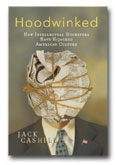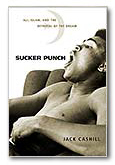Barack Obama: Bill Ayers’ Alter Ego
By Jack Cashill:

Hoodwinked: How Intellectual Hucksters Have Hijacked American Culture
Click here to get your autographed copy of Hoodwinked
Also by Jack Cashill:

Sucker Punch The Hard Left Hook that Dazed Ali and Killed King's Dream
Click here to get your autographed copy of Sucker Punch
© Jack Cashill
The evidence overwhelms the dispassionate observer that semi-retired terrorist Bill Ayers played a major role in the writing of Barack Obama’s memoir, Dreams From My Father.
For those unpersuaded by authorship studies, timelines, parallel themes, matching metaphors, Ayers’ role as neighborhood editor, or Obama’s overnight transformation from struggling hack to literary superstar, allow me to introduce another variable: Obama’s conspicuous channeling of the thoughts and experiences of Bill Ayers into his own presumed autobiography.
In his 1993 book, To Teach, for instance, Ayers lays out the difference between “education” on the one hand and “training” on the other.
“Education is for self-activating explorers of life, for those who would challenge fate, for doers and activists, for citizens,” Ayers writes.
“Training,” on the other hand, “is for slaves, for loyal subjects, for tractable employees, for willing consumers, for obedient soldiers.”
In Obama’s Dreams, these thoughts find colloquial expression in the person of “Frank,” the real life poet, pornographer and Stalinist, Frank Marshall Davis.
“Understand something, boy,” Frank tells the college-bound Obama. “You’re not going to college to get educated. You’re going there to get trained.”
Frank shares Ayers’ distaste for training. “They’ll train you to forget what it is that you already know,” Frank tells Obama. “They’ll train you so good, you’ll start believing what they tell you about equal opportunity and the American way and all that sh**.”
Says Ayers similarly, “What we call education is usually no more than training. We are so busy operating schools that we have lost sight of learning.”
Frank also tells Obama that “leaving your race at the door” is an essential part of the university’s training mission. Ayers makes the same case about training in reference to Indian schools, which insist, according to Ayers, that students be “stripped of everything Indian and taught to be like whites.”
In the same 1993 book, To Teach, Ayers tells the story of an adventurous teacher who would take her students out to the streets of New York to learn interesting life lessons about the culture and history of the city.
As Ayers tells it, the students were fascinated by the Hudson River nearby and asked to see it. When they got to the river’s edge, one student said, ” Look, the river is flowing up.” A second student said, “No, it has to flow south-down.”
Upon further research, the teacher discovered “that the Hudson River is a tidal river, that it flows both north and south, and they had visited the exact spot where the tide stops its northward push.”
In his 1995 book, Dreams From My Father, Obama shares a stunningly similar story from his own brief New York sojourn.
As Obama tells it, he takes an unlikely detour to the exact spot on the parallel East River where the north-flowing tide meets the south-flowing river.
There, improbably, a young black boy approaches this strange man and asks, “You know why sometimes the river runs that way and then sometimes it goes this way?”
Obama tells the boy it “had to do with the tides.” The seeming indecisiveness of this tidal river is used here as a metaphor for Obama’s own. Immediately afterwards, he shakes the indecision and heads for Chicago.
In his 1997 book, A Kind and Just Parent, Ayers tells of a useful reading assignment from the 1992 book, The Kind of Light That Shines on Texas, by black author Reginald McKnight.
The passage in question deals with the travails of Clint, the first black student in a newly integrated school, who tries to distance himself from Marvin, the only other black boy in the school.
“Can you believe that guy?” Clints tells a white student. “He’s like a pig or something. Makes me sick.” Upon reflection, Clint thinks, “I was ashamed. Ashamed for not defending Marvin and ashamed that Marvin even existed.”
In Dreams, Obama reflects on his own first days as a ten year-old at his Hawaiian prep school, a transition complicated by the presence of “Coretta,” the only other black student in the class.
When the other students accuse Obama of having a girlfriend, Obama shoves Coretta and insists that she leave him alone.
Although “his act of betrayal” buys him a reprieve from the other students, Obama, like Clint, understands that he “had been tested and found wanting.”
The shared interest of Obama and Ayers in education may account for their first meeting as well as for these oddly parallel adventures.
In Dreams, Obama describes his “breathless” efforts “working with a citywide coalition in support of school reform.” This took place in the winter of 1987-1988 following the death of mayor Harold Washington.
In To Teach, Ayers tells us how, shortly after his arrival in 1987, “A real [education] coalition had formed among the parents and community organizations.”
“I became involved with that,” says Ayers. “The best friends I have in Chicago today are the result of that development.” It is not a stretch to imagine that Obama was one of those friends.
It is possible too that Ayers had met Obama earlier in the decade during their overlapping years on the Columbia University campus in New York.
Whether or not they had met in New York, Obama relates an experience at Columbia with the kind of insight and regret that only someone like Ayers could have felt and expressed.
As Obama tells it in Dreams, he went to hear the black activist formerly known as Stokely Carmichael speak at Columbia. As he is leaving, he watches ruefully as “two Marxists” scream insults at each other over minor sectarian differences.
“It was like a bad dream,” thinks Obama. “The movement had died years ago, shattered into a thousand fragments.”
These sentiments seem much too knowing and weighty for a 20 year-old just in from Hawaii and LA. They make perfect sense, however, for a radical of nearly 40 emerging from a futile decade in hiding.
In an interview for the book, Sixties Radicals, Ayers makes this clear. “When the war ended, our differences surfaced,” he regrets. “We ended up in typical left-wing fashion: We ate each other… cannibalism.”
Similarly, when the young Obama pontificates about “angry young men in Soweto or Detroit or the Mekong Delta,” one hears the voice of someone much edgier and more aware than Obama.
Ayers was obsessed with Vietnam. It defined him and still does. He knows the emotional weight that a phrase like “Mekong Delta” carries.
Similarly, Ayers would have had a much deeper connection than Obama to “ Detroit,” whose historic riot took place, shortly before Obama’s sixth birthday.
Ayers was posted to Detroit the year after the riot and experienced its fallout first hand. In 2007, on his blog, he “commemorates” the 40 th anniversary of what he predictably calls the “Detroit Rebellion.”
Obama tells us repeatedly that he was only eight years-old when the decade of the sixties ended and knows nothing about it.
I am altogether inclined to take him at his word.

Jack Cashill is the author, among other books, of Hoodwinked: How Intellectual Hucksters Hijacked American Culture. He has a Ph.D. in American Studies from Purdue University.
